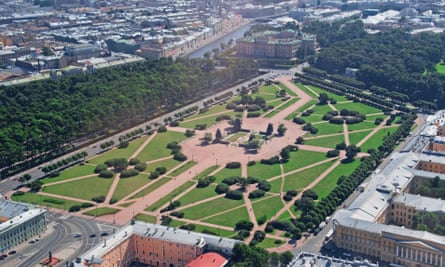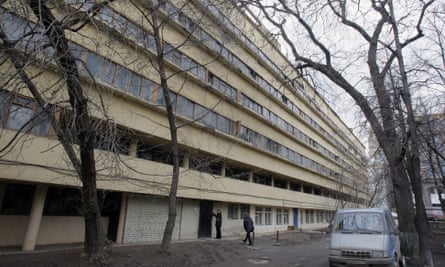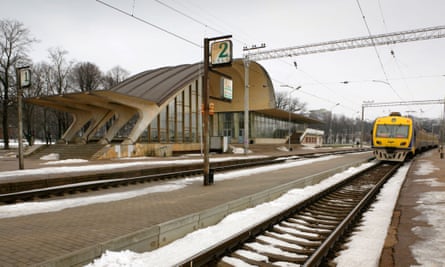A couple of years after the October revolution of 1917, the painter and sculptor Vladimir Tatlin submitted a proposal for the headquarters of the Communist International, as part of a public sculpture competition. Placed on the banks of the Neva, its towering, tilting steel skeleton would have housed the Comintern in glass volumes whose rotation would symbolise revolution and the dialectic.
The most famous building in the 74-year history of the Union of Soviet Socialist Republics was never constructed; in fact, it’s unlikely it could ever have been constructed, though today’s technology makes it a lot more plausible than when it was first proposed in the 1910s. As metaphors go, it sums up Soviet state socialism rather neatly. What was actually constructed tells us a great deal as well: a state whose history is far from monolithic, lurching from openness to terror and back, its architecture from mass production to one-off spectacles, and from Russification to intense engagement with local tradition.
1 | Field of Mars, Petrograd – Lev Rudnev, 1917
This memorial to fallen revolutionaries, placed at the centre of a Tsarist era parade ground, was actually begun between the February revolution that overthrew the Tsar and the October revolution that brought the Bolsheviks to power. The square is surrounded by heavy slabs of red granite, topped with red flags, with inscriptions by the commissar of enlightenment, Anatoly Lunacharsky – the effect is spacious, original and imposing. Rudnev, its young architect, became notorious 30 years later for Stalinist skyscrapers in Moscow and Warsaw.

2 | Traktornaya housing development, Leningrad – Gegello, Nikolsky and Simonov, 1925
A peculiar outlier in Soviet architecture, and the first major housing scheme in the USSR, Traktornaya takes its cue from the classical tradition of St Petersburg, with its attractive colour scheme, calm and orderly layout, and its strange deconstructed triumphal arches. More comparable to Nordic Classicism in contemporary Sweden or Finland than to Soviet Constructivism, the estate housed workers at the Putilov engineering works, who had been the backbone of the Bolshevik ranks in 1917. Today it forms part of the Narvskaya Zastava district, a showcase for 1920s avant garde architecture.
3 | Narkomfin communal house, Moscow – Moisei Ginzburg, 1928
This much more ambitious housing project was a showcase of what was called “the new everyday life” in the 1920s – a Constructivist communal housing scheme. A sleek row of duplex flats, many of them without kitchens, are connected by walkways to a glass box with collective canteens, a library, gym and roof garden, as part of a programme for the reform (or elimination) of family life. The social ideas behind the building were abandoned within a couple of years of completion, but its architectural ideas were plundered by west European architects like Le Corbusier, Wells Coates and Denys Lasdun. The building itself, which sits on extremely valuable real estate, is falling apart. Ironically, many of its ideas about social spaces in apartment buildings are widely accepted in luxury flats.

4 | Mayakovskaya metro station, Moscow – Alexey Dushkin, 1938
The Moscow Metro – along with its later cousins in St Petersburg, Kiev, Baku, Tashkent, Kharkiv, Yerevan and elsewhere – has a claim to being the most astonishing project of Soviet architecture. Mayakovskaya could even be the most breathtaking underground station ever constructed. Its gorgeous chrome and marble hall was a result of one of the most brutal construction projects of the 1930s, with appalling safety standards, a high casualty rate and widespread use of convict labour. On the domed ceilings of this incredibly deep station – built to serve as a bomb shelter, which it did – is a glittering, vertiginous mosaic series by the great realist painter Alexander Deineka, depicting a “24-hour Soviet sky”.

5 | Ministry of Foreign Affairs, Moscow – Gelfreikh and Minkus, 1948
After the war, the devastated Soviet state diverted precious resources into a seemingly whimsical project of seven triumphalist skyscrapers. Six of them were situated along Moscow’s Garden Ring – huge, monsters of buildings taking up entire city blocks and rising to spires modelled on those of the Kremlin, allegedly at the insistence of Joseph Stalin himself. Three more were built in newly acquired, or “fraternal” cities: Riga, Warsaw and Prague. The best of the Moscow seven is the Ministry of Foreign Affairs, where the upright, gothic rhythm gives the tower a sense of intimidation, horror and evil appropriate to its purpose at the height of the Cold War.
6 | Dubulti Railway Station, Jūrmala – Igors Javeins, 1977
When Nikita Khrushchev condemned the “excesses” of Stalinist monumentality in 1956, Soviet architecture underwent the third of its many sudden stylistic switches, this time back to modernism. Some of the results were banal, but a lot of it was optimistic, free-form architecture. This seaside railway station in Latvia is a superb example, showing an enthusiasm for sculptural concrete shell structures that the Soviets borrowed from the 50s architecture of California. Clear, light and effortless despite its gravity-defying cantilevered form, it stands between the Baltic sea and a river, and now contains an art gallery along with the ticket booths. The dates, though, tell a less encouraging story – the building looks like a classic design of the 50s, but was completed in 1977, when fashions elsewhere had long since moved on.

7 | Crematorium, Kiev – Avram Miletsky, 1968-1981
This sombre, unique building often features today in photo books of “awesome futuristic Soviet architecture”. Strange, maternal-looking creatures squat at the bottom of a hill near the Ukrainian capital’s main cemetery. Close up, the gates to these things (crematoria, it transpires) are twisted metal doors that resemble the work of HR Giger; concrete flames lap around them. The long gestation period reflects the fact that the crematorium was originally adjoined by a wall of relief sculptures on 20th-century suffering, something that Kiev saw more of than most places. Controversial from the start, it was covered up with a layer of plaster before the building was opened.
8 | Ministry of Highways, Tbilisi – George Chakhava, 1974
This photogenic clustered high-rise office block consists of several mini towers intersecting on their way down a steep hill, facing the river Kura. Inspired by the pile-up of interlinked Persian-style houses in Tbilisi’s old town – according to its architect – it stands as a lone monument on the main road out of the Georgian capital, and the difficulty of pedestrian access is some sign of the Ministry of Highways’ success.

9 | City Gates, Chișinău – Skvotsova, Markovich and Spasov, 1980
Late Soviet architecture was often a compromise between the heavy, decorative monumentality of the Stalin era and the mass production and modernity of the 20s and 60s. The almost maniacal pomp and grandeur of the Chișinău City Gates combine a baroque sense of axial symmetry and approach with prefab concrete technology and a lot of architectural sleight of hand. They’re literally the first buildings you see on approaching the the Moldovan capital from the airport, and as you get further into the centre, the buildings get smaller and more dilapidated – the exact opposite of the way most capital cities have been designed.
10 | Palace of Pioneers, Dnipropetrovsk – Amosov, Solodovnik, Garsia Ortega and Klever, 1991
The completion date for this building in eastern Ukraine’s industrial metropolis makes it one of a few candidates for “last Soviet building”. It shows another shift; this time to a lightness of touch, even a certain amount of wit, that would be lacking in most post-Soviet architecture as much as it was in Leonid Brezhnev’s USSR. This “palace” for young people is scaled to meet its users, but filled with goofy space-age details for their enjoyment, with portholes, mazes, flying walkways and bizarre multicoloured sculptures, on a secluded, verdant site near the Dnieper river. The idea behind the Pioneers was to raise children to be good communists – unlikely for the generation of kids who have used this building since 1990.
What are your favourite Soviet buildings? Tell us in the comments below, or follow Guardian Cities on Twitter and Facebook and join the discussion

Comments (…)
Sign in or create your Guardian account to join the discussion